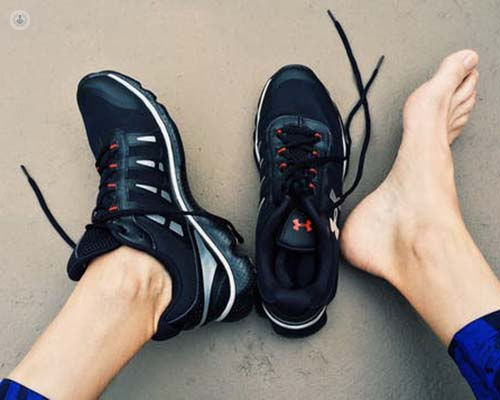How to treat a sports-related ankle sprain
Autore:Lateral ligament ankle injuries, such as an ankle sprain are common sports-related problems seen by physiotherapists and specialists. Here, orthopaedic surgeon Mr Abhijit Guha explains what to do if you have one, from the moment it happens or in cases where the sprained ankle is not healing long-term.

How should I treat my ankle injury from the very beginning?
Initially, rest, ice compression and elevation should resolve the swelling and the bruising and then, gradually, with a little bit of help from maybe a crepe bandage or similar support, you can gradually get back to normal.
If despite this, you still get the feeling of instability, you need to see a physiotherapist. With proprioception exercises that are done under the supervision of the physiotherapist, around 90% of these injuries do tend to heal.
When is it time to see a specialist?
For the 10% of patients who continue to be symptomatic - with the feeling of instability and the feeling of going over on the ankle almost at any time - they need to be assessed by an orthopaedic foot and ankle surgeon.
How does a foot and ankle specialist further treat lateral ligament ankle injuries?
If there is clear instability of the ankle compared to the other normal side, then further confirmation of the diagnosis is usually done with an MRI scan. We then proceed to an anatomical reconstruction of the ligament which is called a Broström-Gould procedure. This operation is a simple one and it works brilliantly. Almost all patients do tend to recover strength and stability in the ankle.
What happens after surgery for an ankle sprain?
For two weeks, you are non-weight-bearing after the operation. Then for a further two weeks, you are weight-bearing with the leg protected in a cast. At four weeks you start mobilising with physiotherapy to strengthen your feeling of balance in the ankle and also to strengthen your calf musculature.
Who can have the Broström-Gould procedure?
One thing which is of utmost importance in the management of lateral ligament injuries of the ankle is the fact that the anterior talofibular ligament often heals but in an elongated position. On an MRI scan, the ligament will be seen in continuity and the report will say that the ligament is intact or healed.
However, in clinic, if the patient has clear signs of instability of the ankle, they will certainly improve with a Broström-Gould repair of the ligament. Therefore the diagnosis is mainly clinical and an MRI scan is just there to supplement your diagnosis, but despite a normal report on an MRI scan I have operated on patients with clear instability and they have been delighted with the outcome.
Do not hesitate to book an appointment with Mr Guha if your ankle pain is not healing.



